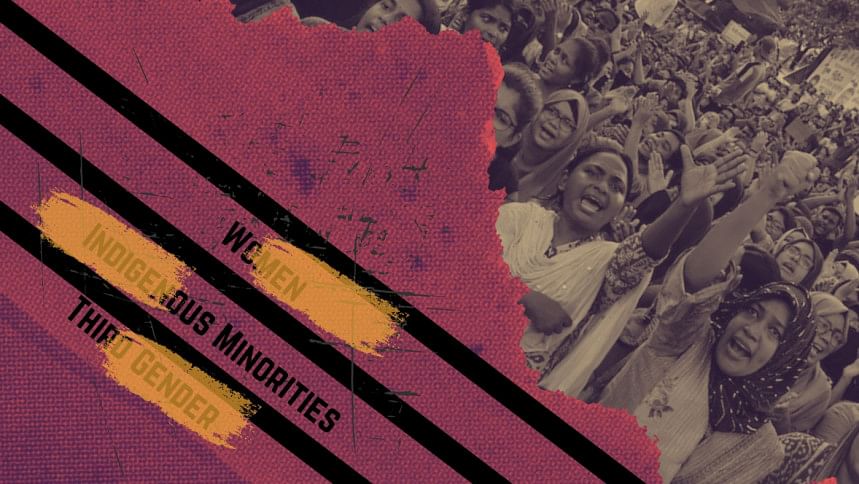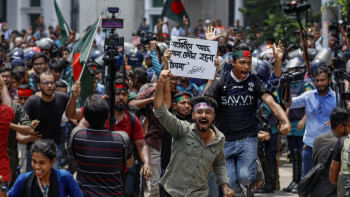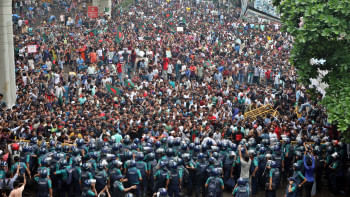The (reformed) quota scheme, our state, and the marginalised

The quota reform movement took a rather avoidable violent turn, particularly agitating and disconcerting teachers of law, who research and lecture university students on rights, justice, and constitutionalism.
The movement tabled for us the logical demand to reform the quota scheme in public service. Indeed, the quota scheme needed substantive reform. By substantive, I refer to reform that goes beyond specifying the percentages. In the face of the overwhelming loss of lives, disproportionate and careless use of force, condemnable violence against police personnel, jailbreaks, and mindless destructions caused by "vested quarters" to public properties and national establishments, it was understandably not possible to go into the substance of quota reform. But while we heave a sigh of relief, it is important to also reflect on how different things could have been, had the state taken a dialogic approach with the protesting students early on. Even with regard to the strategic mayhem apparently planned and perpetrated by third-party political and/or extremist elements, we cannot understate the accountability of the state mechanism on account of their share of omissions to make sure that the student movement does not slide into violence and is not taken "advantage" of (for example, failing to collate and build required security intelligence or not strategising/deploying preventive and countering measures early on).
One may say that I am imposing too daunting of a burden on the state and that in fact the students should have shown "maturity" and framed their demands the right way. Interestingly, for instance, it is argued by state officials that the protesting students, including women, did not want quotas for women. However, we ought to be mindful to the legal, normative, and epistemic authority that the state has over us—the governed.
This piece may seem rather pedantic at this point. However, as a feminist who deeply cares about substantive equality, I cannot help emphasising that had things panned out differently, the quota percentages could also have been specified based on data-driven grassroots evidence on substantive inequalities and statistical analyses on the marginalised communities. As it transpires, we (the state as a whole) lost the righteous high ground to negotiate with the protesting students.
There are many ways to justify quotas. First, they further the cause of substantive equality. Quotas offer support to the otherwise marginalised to compete on equal terms with those who are not. A second justification for quotas is they work as "recognition" for past intentional discrimination, oppression, or harms. A third justification is that quotas tend to contribute to diversity. However, the diversity argument reduces humans to group identities—to something of use—something that adds value to a setting. In a way, it views humans as instruments and not as beings having intrinsic value. Nonetheless, diversity is a valid argument to justify quotas.
Clearly, quotas are not an exception to equality—as per the tenets of anti-discrimination law jurisprudence. Courts across jurisdictions have observed on multiple occasions how affirmative actions are an intrinsic part of formal equality, and not an exception to it. However, for quotas to work as an intrinsic element of formal equality and to further the cause of substantive equality, they need to be implemented with an overarching vision. For quotas to be beneficial, it is important that they take a "prioritarian" approach and do not generalise or essentialise groups or categories that they target. In other words, to further the cause of substantive equality, it is crucial that quotas do not compromise with qualification in the longer run, do not perpetuate stereotypes, and are not over- or under-inclusive. Quotas, at the end of the day, are remedial, they are not supposed to treat the structural barriers or systemic causes of substantive inequalities. However, with vision of an egalitarian society, it is important that quotas are utilised as a "plus" to treating the root causes of inequality, discrimination, and marginalisation, and not as a tokenistic scheme to mask inequalities that lurk underneath formal equality or as means to engender further discrimination or inequalities. Evidently, the state lacked a vision: it never knew what it wanted quotas to do. Alternatively, the state failed to meaningfully communicate a vision to the protesting students.
While upholding a race conscious admission policy by the University of Michigan, the US Supreme Court observed that a quota policy must be sufficiently flexible to ensure that each applicant is evaluated as an individual and not in a manner that makes ethnicity or race the defining feature of an application. Thus, race or ethnicity may be considered only as a "plus" to a particular applicant's profile. In other words, when there is one position and two equally qualified persons, then the balance shall tilt in favour of the one who has a quota in their favour. Indeed, this is one of the ways quotas can do their job and still not compromise with qualification. Another way is to choose a quota-candidate over a non-quota candidate (both equally qualified) unless there are additional factors favouring the case of the latter. What we have in our country are automatic quotas, meaning that when quotas come in play, they do not work as a "plus" to the applicants' profile, rather become the defining factor of their applications. Hence, instead of unmindfully retaining or reducing automatic quota provisions, it was (and still is) important to craft a plan on transitioning from automatic quotas to a more nuanced application of quota provisions based on certain benchmarks (for example, obtaining critical mass).
The answer to the question of over-inclusivity lies with a prioritarian approach to executing quotas. India is illustrative in this regard for sub-dividing marginalised groups. Indeed, sub-dividing beneficiary groups and prioritising the most marginalised within a specific group, if perfectly executed, is one way through which quotas can really do the job they are supposed to do. This is where excluding the "creamy layer" or otherwise socioeconomically advanced section within specific groups comes into play. In order to prevent under-inclusivity, quotas need to be regularly monitored and revised based on disaggregated data and evidence on marginalisation and intersectional harms sustained by members of specific groups.
History shows how the "woman question", "indigenous question", "transgender question", and "disabled question" get subsumed in the midst of dominant voices and how marginalised voices get deliberately silenced amid battling causes and agendas. The quota reform movement, the state's initial nonchalance, and the mayhem befalling the country afterwards serves as a case study for such subsuming and silencing. Indeed, the reformed scheme does a great disservice to women by entirely foregoing quotas for them. It's true that for a privileged class of mostly urban women, quotas are no longer needed. However, they do not represent all women—particularly those who sustain harms on multiple intersecting grounds. In order to recognise the historical wrongs perpetrated against women in general and to cater to the needs of the vast majority of women with no access to basic goods and services, quotas are a necessity and will continue to be so for quite a while. One per cent quota for the indigenous population is certainly not backed by evidence either. Amid all, specifying quota for the "third gender" individuals is commendable. However, the clubbing of persons with physical disabilities with "third gender" individuals (with one per cent quota) does not add value to the cause of equality since the two are different categories, sustain distinct harms, and have varied needs. Moreover, the court verdict did not have the word 'physical' in referring to persons with disabilities, which the circular added, and thereby took a further non-inclusive approach. Unmindful to the majoritarian backlash against transgender people, the new scheme also reifies the regressive agenda of distinguishing "third gender" individuals from non-cisgender people in general and thereby hierarchising gender identities. Does it also reinforce the regressive stigma attached to non-cisgender people to the effect that they are persons with (gendered) disabilities? I do not know.
At the end of the day, what we have with the new quota scheme are "subaltern" lives and lived experiences, that will remain, perhaps indefinitely, almost unaccounted for within the public employment sector—due to the political-apolitical 'sensitivity' now attached to the scheme in general.
Above all, we have the burden of the lost lives to account for.
Psymhe Wadud teaches International Human Rights Law at the University of Dhaka.
Views expressed in this article are the author's own.
Follow The Daily Star Opinion on Facebook for the latest opinions, commentaries and analyses by experts and professionals. To contribute your article or letter to The Daily Star Opinion, see our guidelines for submission.

 For all latest news, follow The Daily Star's Google News channel.
For all latest news, follow The Daily Star's Google News channel. 










Comments